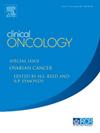放疗在转移性宫颈癌中的作用:一项真实世界的研究
IF 3
3区 医学
Q2 ONCOLOGY
引用次数: 0
摘要
目的放疗(RT)治疗转移性宫颈癌(mCC)的疗效数据有限。在此,我们评估了RT治疗mCC的效率。材料与方法本研究为回顾性队列研究。2018年4月至2022年4月共99例mCC患者接受放疗组(RT组)或非放疗组(NRT组)治疗。所有患者均接受全身治疗。结果两组患者的完全缓解率(CRRs)分别为15.8%和4.8% (P = 0.322),客观缓解率(ORRs)分别为68.4%和42.8% (P = 0.011)。中位随访时间为16个月(5-53个月)。RT组总生存率(OS)(1年82.5% vs 57.1%, 2年60.7% vs 31.1%, P = 0.035)和无进展生存率(PFS)(1年64.7% vs 35.7%, 2年41.3% vs 24.4%, P = 0.022)较高。RT将中位OS (mOS)从16个月延长至27个月,中位PFS (mPFS)从9个月延长至18个月。多因素分析显示,放疗、5-8个化疗周期和非肝转移是OS和PFS的独立预后因素。亚组分析显示,60岁以上、鳞状细胞癌、单器官转移和接受2-4个化疗周期的患者接受RT治疗后,OS和PFS均有改善。此外,值得注意的是,仅淋巴结转移患者接受放疗后的OS增强(78.9% vs 50.0%, P = 0.029)。主要急性不良事件为血液学毒性。结论放疗联合全身治疗可提高mCC的客观有效率。它还可以改善OS和PFS,延长mCC的mOS和mPFS,而不会增加治疗相关的毒性。对于60岁以上的鳞状细胞癌、单器官转移、仅淋巴结转移、接受2-4个化疗周期的患者,建议积极RT干预。在mCC中,建议谨慎选择患者进行RT。本文章由计算机程序翻译,如有差异,请以英文原文为准。
The Role of Radiotherapy for Metastatic Cervical Cancer: A Real-World Study
Aims
Data on the efficacy of radiotherapy (RT) in metastatic cervical cancer (mCC) are limited. Herein, we evaluated the efficiency of RT for mCC.
Materials and methods
This is a retrospective cohort study. A total of 99 patients with mCC from April 2018 to April 2022 were treated with either radiotherapy group (RT group) or non-radiotherapy group (NRT group). All patients received systemic treatments.
Results
The complete response rates (CRRs) were 15.8% and 4.8% (P = 0.322) and the objective response rates (ORRs) were 68.4% and 42.8% (P = 0.011) in the RT group and NRT group, respectively. The median follow-up was 16 months (5–53 months). The RT group showed higher overall survival (OS) (1-year 82.5% vs 57.1%, 2-years 60.7% vs 31.1%, P = 0.035) and progression-free survival (PFS) (1-year 64.7% vs 35.7%, 2-years 41.3% vs 24.4%, P = 0.022). RT extended median OS (mOS) from 16 to 27 months and median PFS (mPFS) from 9 to 18 months. Multivariate analyses revealed radiotherapy, 5–8 chemotherapy cycles, and nonhepatic metastasis as independent prognostic factors for OS and PFS. Subgroup analysis showed improved OS and PFS with RT in patients aged over 60, with squamous cell carcinoma, single organ metastasis, and those receiving 2–4 chemotherapy cycles. Besides, notably, enhanced OS was observed in patients with lymph node-only metastasis who received RT (78.9% vs. 50.0%, P = 0.029). The primary acute adverse event was haematology toxicity. There was no increased toxicity with the addition of RT.
Conclusion
Radiotherapy combined with systemic therapy demonstrates an increased objective response rate for mCC. It can also improve OS and PFS and extend mOS and mPFS for mCC without escalating treatment-related toxicity. For patients aged over 60, with squamous cell carcinoma, single organ metastasis, lymph node-only metastasis, and those receiving 2–4 chemotherapy cycles, proactive RT intervention is recommended. Careful patient selection is advised for RT in mCC.
求助全文
通过发布文献求助,成功后即可免费获取论文全文。
去求助
来源期刊

Clinical oncology
医学-肿瘤学
CiteScore
5.20
自引率
8.80%
发文量
332
审稿时长
40 days
期刊介绍:
Clinical Oncology is an International cancer journal covering all aspects of the clinical management of cancer patients, reflecting a multidisciplinary approach to therapy. Papers, editorials and reviews are published on all types of malignant disease embracing, pathology, diagnosis and treatment, including radiotherapy, chemotherapy, surgery, combined modality treatment and palliative care. Research and review papers covering epidemiology, radiobiology, radiation physics, tumour biology, and immunology are also published, together with letters to the editor, case reports and book reviews.
 求助内容:
求助内容: 应助结果提醒方式:
应助结果提醒方式:


